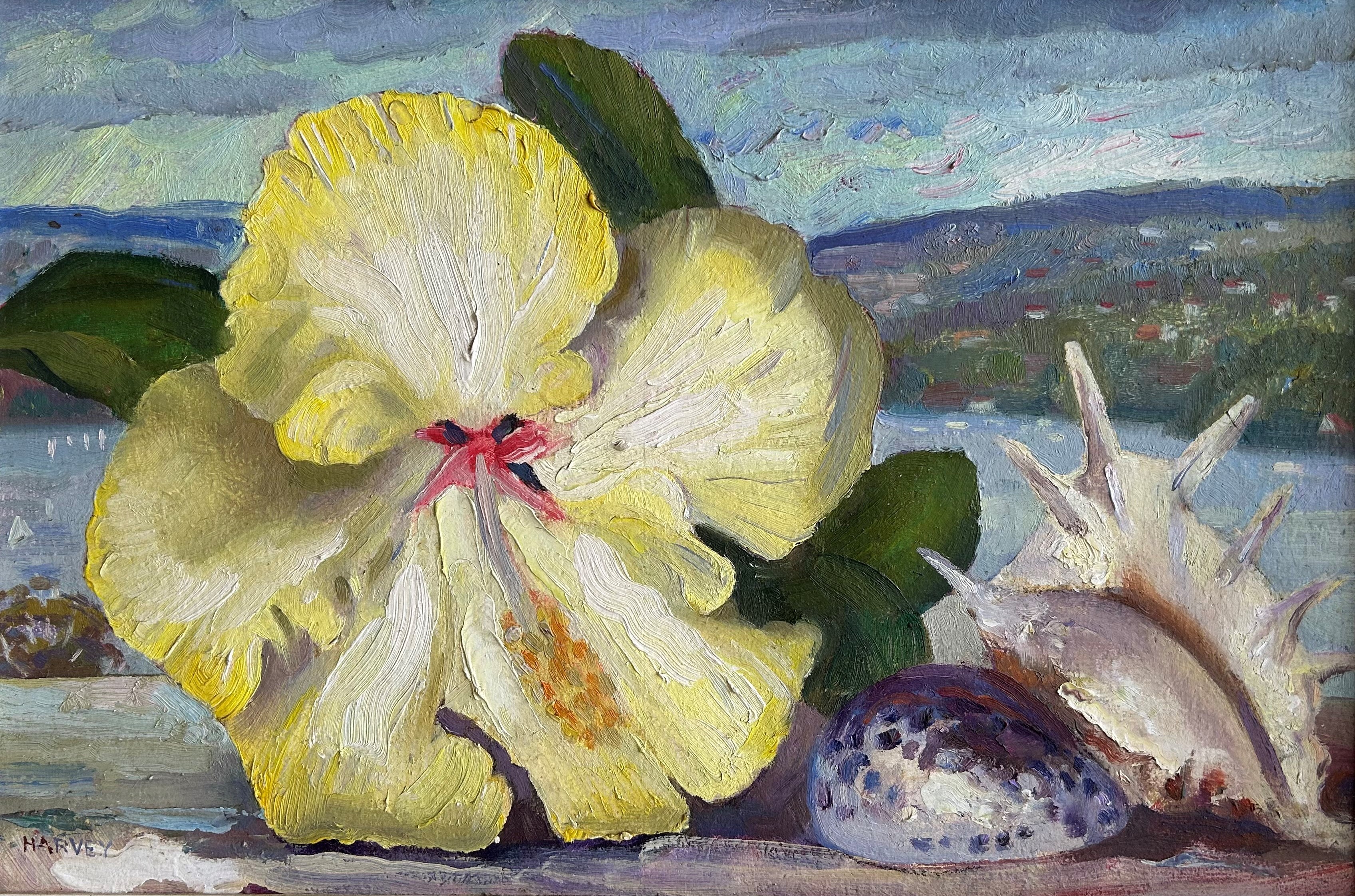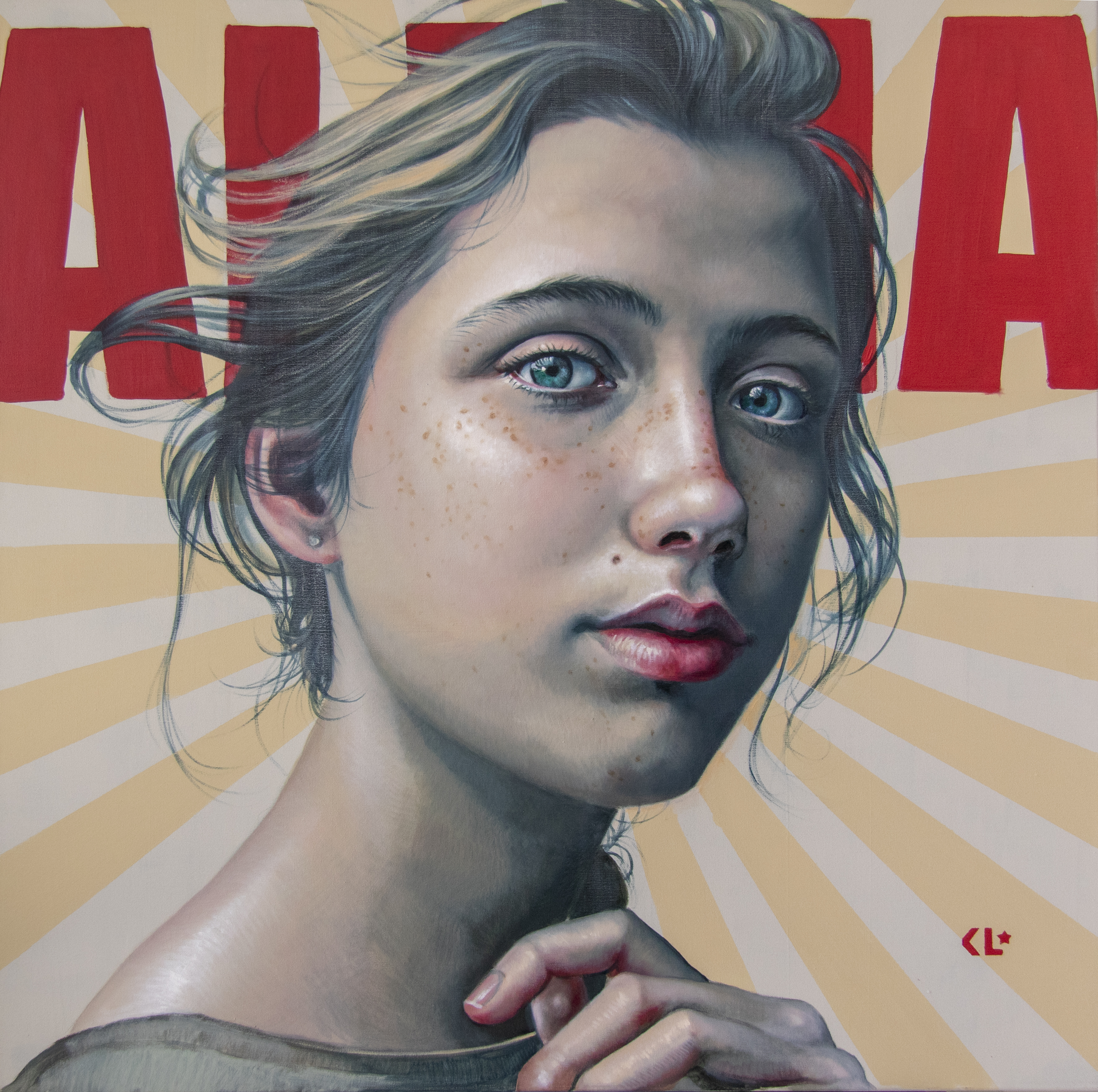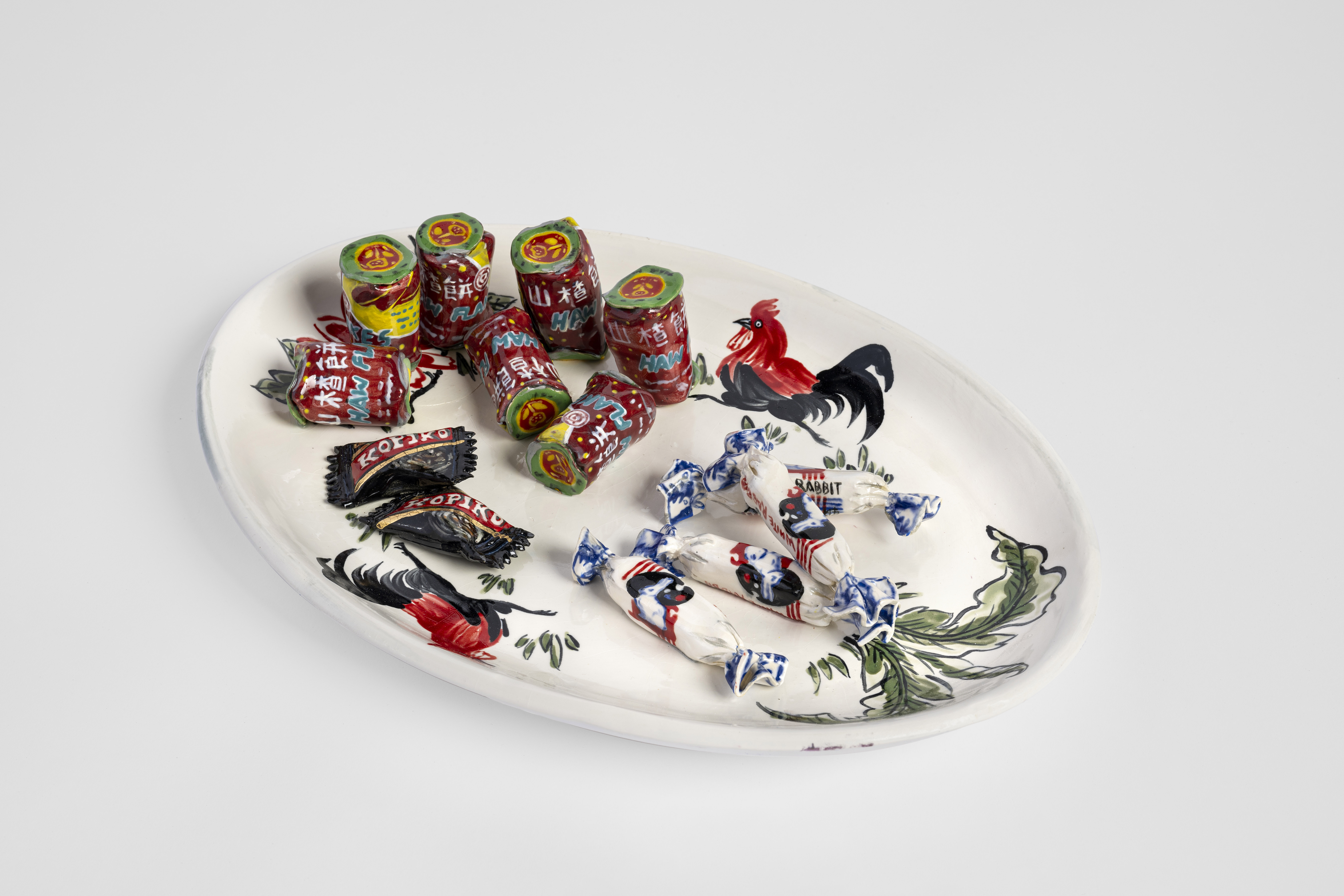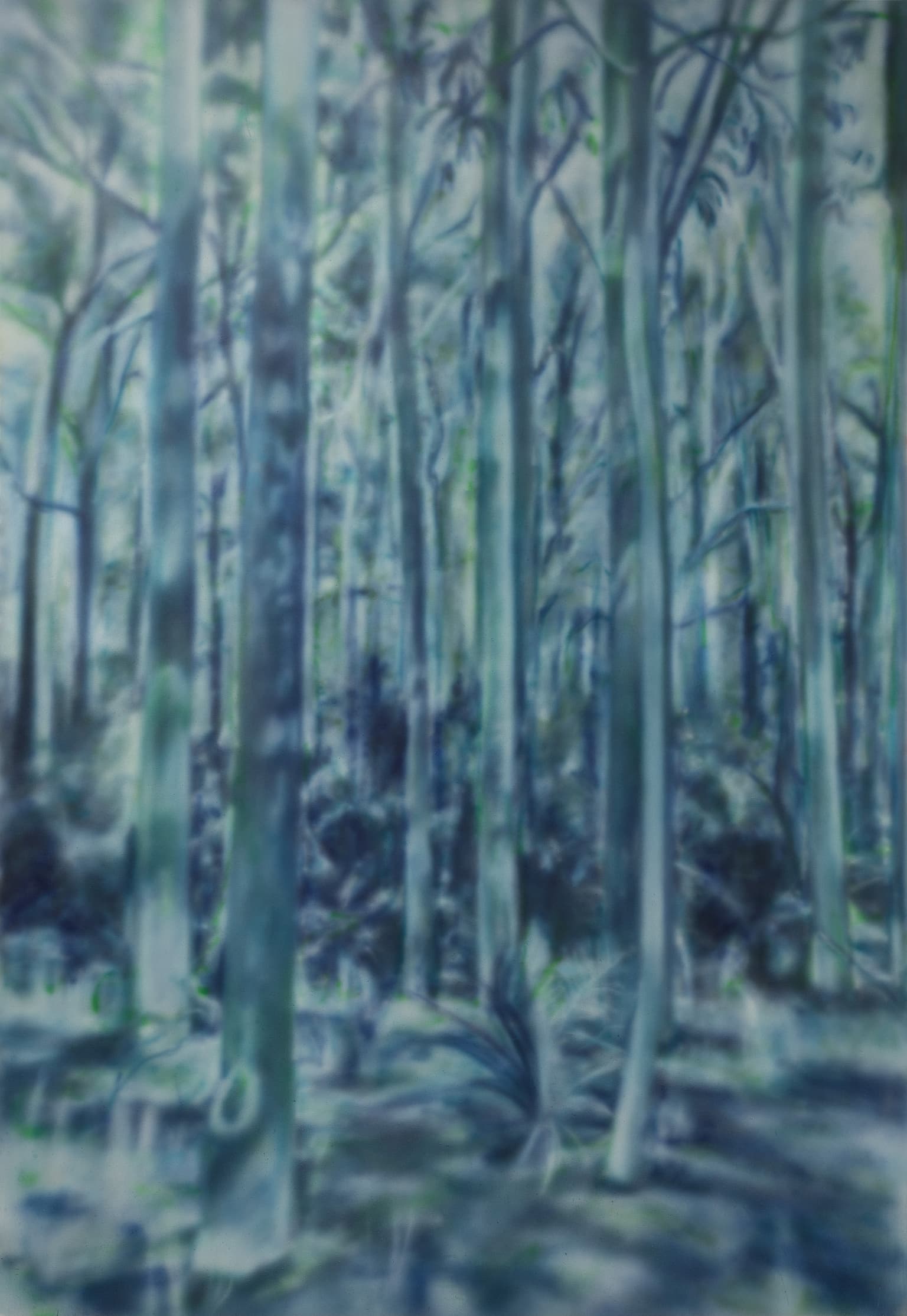
Through the generosity of artists and donors, MAG&M continues to be able to develop its collections. Here are some of the most recent additions to our significant and diverse collection.

Edmund Arthur Harvey
Untitled (Still Life over Middle Cove), c.1950, oil on board, 27 x 35cm
Gift of Meg Stewart 2024
This small painting by E. A. Harvey is depicts the water landscape of Middle Harbour, painted from Castlecrag in Sydney where the artist and his family lived for many years. It was donated recently by Meg Stewart. The donor’s mother, artist Margaret Coen, met Harvey, as she always called him, when she was a young art student, and in 1932 he painted her portrait which is now part of State Library of NSW’s art collection and is on permanent public display in the Mitchell Galleries.
Harvey was also great friends with the late Avalon-based artist Arthur Murch, the pair first meeting when by coincidence they travelled to England on the same ship in 1925 and were together in Europe. Back in Sydney, for a period Harvey and Murch both worked in the Randwick studio of George Lambert. To paint Margaret Coen’s portrait, Harvey borrowed a studio from the artist Miriam Moxham (also represented in MAG&M’s collection with a portrait of Antonio Dattilo Rubbo) in a condemned building in Margaret Street, Sydney which was full of other artists taking advantage of it empty spaces. In 1935, Harvey and Murch worked at the School of Decorative Arts, situated at the corner of Liverpool and Castlereagh Streets, Sydney.
In 1935 also, Harvey became a part-time art teacher at East Sydney Technical College (now the National Art School) in 1935, and a full-time art teacher in the NSW Department of Technical Education in 1940. He was an art teacher (part-time 1936–1940, full-time 1940–1971) at North Sydney Technical College and ESTC. He became Head of the North Sydney Technical College annexe of East Sydney Technical College, and Senior Head Teacher. In 1972 Harvey was Senior Head Teacher of Diploma Painting, Fine Arts Division, at the National Art School. He retired at the end of 1971, after 37 years teaching at the National Art School, and continued to paint until his death.
My mother always had a soft spot for Harvey because she loved his portrait of her – because of it painting qualities not because of her being the subject. So, when he had a retrospective exhibition at the Woolloomooloo Gallery in October 1985. she was determined to buy one of paintings. Together she and I chose the work now being offered to the Manly Gallery and it would be great to have it now added to the collection. (Meg Stewart)

Jude Rae
SL490 (with loud hailer), 2024, oil on linen, 61 x 71cm
The acquisition was made possible with funds provided by MAG&M Society, and private donors including Brian Hamer, Cyndi Jaques and Joanne Willcocks.
To celebrate 100 years of public collecting at Manly Art Gallery & Museum, the Gallery commissioned contemporary Australian artist Jude Rae to create a work for the Collection. As a direct response, SL490 (with loud hailer) pays homage to an early surf lifesaving loudhailer from MAG&M’s museum objects collection.
Raised on the Northern Beaches, Jude Rae is primarily known for her still-life paintings, portraits, and architectural interiors. The low-key, non-narrative imagery she employs allows the attention to dwell on the formal and material aspects of representational painting, encouraging a more reflective and considered approach to the complexities of visual experience.
Jude Rae is a two-time winner of the Portia Geach Memorial Award for portraiture, a three-times Highly Commended finalist of the Archibald Prize, and the recipient of the prestigious Bulgari Art Award presented in partnership with the Art Gallery of NSW. In 2017, a survey of her work was held at the Australian National University Drill Hall Gallery.
After graduating in Fine Arts (History) at Sydney University, Jude Rae taught at City Art Institute (University of NSW) and in 1987 had her first solo show with Painters Gallery. At this time, she was also a founding member of the Ultimo Project Studios, an urban housing co-operative for artists in Sydney. In 1989 she moved to London and later to New Zealand where she was the first Director of South Island Art Projects, which today exists as the Physics Room, Christchurch, NZ.
Over the last forty years Jude Rae has exhibited her work in Australia, New Zealand, Germany and the USA. She has been awarded residencies in France, Italy and New Zealand, and has taught at a variety of art schools including Auckland University, the Australian National University and most recently at the National Art School, Sydney.

Joshua Yeldham (b.1970)
Owl of Blue Bells, acrylic on hand carved paper, 197 x 194cm, 2022
Gift of the artist through the Australian Government’s Cultural Gifts Program 2023
This recent painting by multidisciplinary, Northern Beaches based artist Joshua Yeldham (b.1970) complements an earlier work, Resonance - Morning Bay donated in 2018, which sees MAG&M now representing the artist’s key subject matters – the mangrove landscape and owls of the Hawkesbury River region.
Deriving from a deep spiritual affiliation with the land and a reverential love of nature, Yeldham’s art practice forms a interplay between narrative and myth, and imagination and experience. Working across painting, photography, drawing and sculpture, the artist has developed a singular aesthetic that often conflates these various mediums, such as his characteristic oil paintings with sculptural assemblages on board or his pierced and carved photographs. His distinctive visual language fuses the physical elements of the landscape with the metaphysical modalities of history and mythology.
Yeldham has exhibited widely throughout Australia and internationally. He was the subject of MAG&M’s major survey exhibition, Surrender in 2014. In 2017 he was awarded the prestigious Nancy Fairfax Artist Residency at Tweed Regional Gallery & Margaret Olley Arts Centre, Yeldham has been a finalist in numerous awards including the Wynne Prize, Archibald Prize, Sulman Prize and Mosman Art Prize.

Kathrin Longhurst (b.1971)
Alpha, oil on linen, 91 x 91cm, 2021
Gift of the artist through the Australian Government’s Cultural Gifts Program 2023
German-Australian figurative artist Kathrin Longhurst (b.1971), who is based on the Northern Beaches, recently donated to MAG&M this painting from her Mind-Field series. Her work has previously been shown in MAG&M’s 2022 exhibition, Settled Unsettled: art on the asylum seeker, migrant and refugee experience.
In this painting, Longhurst places her female subject against the backdrop of an emotionally charged word Alpha. She presents her female subjects as strong and dominant entities, and pushes them to the forefront of the canvas. Unlike traditional figurative paintings, which render women diminutive, chaste and in need of protection, these works exude strength as well as vulnerability, forcing the viewer to consider the complex relationship between labels and identity.

Mechelle Bounpraseuth (b.1985)
Rooster Plate with Haw Haw, Kopiko and White Rabbit Candy, glazed earthenware and gold lustre, 7 x 35 x 25.5cm, 2023
Purchased with funds generously provided by the Art & Soul Collective Inc, 2023
Mechelle Bounpraseuth’s art practice includes drawing, video, zines and ceramics. She uses her work as a way to understand and process the loss of cultural heritage, inherited trauma, childhood memories, and as a way to navigate her own identity. The subject of her artworks are primarily domestic objects and scenarios that depict memories or events found in the past, and how these objects can become “a marker for a point in my life, and a symbol which represents what my childhood was.” Ingrained within the glaze lies a storied past, a sharp contrast to the jubilant initial exterior impression — something mirrored in Bounpraseuth’s creative mindset.
Bounpraseuth graduated from the National Art School in 2016 and was awarded the Trudie Alfred Bequest Scholarship. She has since been the recipient of the Highly Commended Prize, Woollahra Small Sculpture; Fishers Ghost Prize for Sculpture and the Macquarie Group Emerging Art Prize. Recent exhibitions include Ceramic pipes, socks & globular, bumpy, suggestive objects, Conners Conners, Fitzroy, VIC and Female Drivers, Maitland Regional Gallery, NSW. Her artworks have been published in Art Almanac, Art and Australia, The Journal of Australian Ceramics and Art Collector. Mechelle is represented in Sydney by Chalk Horse Gallery.

Blak Douglas (b.1970)
"" #1 (Expiry date), 2023
Commissioned with funds generously provided by the Art & Soul Collective Inc, 2023
Dhungatti artist Blak Douglas says of this painting that “I wished to pay tribute to the aquarium zoned for demolition - a structure that no doubt holds considerable nostalgia for many, but not without its flaws. My sentiment in including the ‘Australian’, Pirate and Christian fish flags acknowledges the well-meaning aspect of nature conservation. However, to keep or house marine life is not a practice of First Nations peoples. The commodification of fish could only have resulted from capitalist ideals.”
This painting is currently showing in MAG&M’s exhibition “Inverted Commoners: Gayamay/Manly Cove” (21 April – 30 July 2023) by Blak Douglas. It is part of a new body of work that explores the narrative of Gayamay / Manly Cove viewed from a First Nations perspective, and brings to the fore issues of place and displacement.
By naming people and places, we confer identity. In Australia, many original place names have been lost and, as a contemporary society we are in a process of rediscovery. Gayamay/Manly Cove, as a point of first contact between First Nations and the British, therefore has particular significance.

Josephine Nangala (b.1950)
Untitled, 2005, acrylic on canvas, 38 x 46cm
Josephine Nangala was born c.1950 and is a Kukatja Manyjilyjarra woman from the Kiwirrkurra community, Papunya Tula Artists.
Josephine grew up with her family travelling between Nyirla, her traditional Country, and the Canning Stock Route, Western Australia. She lived in Balgo before moving to the Kiwirrkura community with her husband, artist Charlie Wallabi Tjungurrayi.
Nangala has exhibited widely; her work featured most recently in Sydney Contemporary 2019 at Carriageworks, and in ‘Community XI’ at Utopia Art Sydney the same year.
This work was recently donated to our collection by former MAG&M Director, Dr Therese Kenyon, along with five other paintings by artists Yuyuya Nampitjinpa, Nanyuma Napangati, Imelda Yukenbarri Gugaman, Theresa Nowee and Pirrmangka Napanangka.
Supported by a Gordon Darling Foundation travel grant in 2005, Kenyon travelled to Aboriginal art centres across Australia with collector Helen Read. The works acquired during that trip have been generously donated, expanding MAG&M’s collection of First Nations art and culture.

Noel McKenna (b.1956)
Three trees, South Coast, 2002, glazed ceramic tile, 20 x 20cm
Investigating notions of place, Noel McKenna (b.1956) works across painting, watercolour, sculpture and ceramics. His works are seen as a mode of storytelling through the unity of natural, structural and human elements.
McKenna works in a naïve style yet it his is a highly considered arts practice. He is a prodigious maker of prints, artist books, ceramics, paintings and sculpture that humorously depict aspects of everyday life.
McKenna has been awarded the Wynne Prize for watercolour five times and is regularly shortlisted for the Archibald, Wynne and Sulman Prizes. McKenna’s work has been featured in many significant national and international group exhibitions, including most recently in CERAMIX at Manly Art Gallery & Museum, Sydney (2021).

Hadyn Wilson (b.1955)
Where artists work, 1988, charcoal on paper, 120 x 84cm
This drawing is part of a series of works exploring the life of the artist. It alludes to hardship, cramped living and working conditions, and how artists manage somehow under difficult conditions. The artist explains;
“In the 1980s, I was working on a series of drawings which featured figures which symbolically represented the human condition in various social settings. This drawing in charcoal was a commentary on the difficulty of finding suitable studio space in large cities and the inevitable compromises that needed to be made.
Looking back now, the spaces I managed to find in places like Ultimo and later Glebe (The Ultimo Project) seemed quite generous and affordable compared to the high rents and unavailability that exists now. If anything, the drawing seems more relevant now than when it was made in 1988 and housing shortages effect people from many stratas of society.
However, the artist’s creative capacity will eventually find ways around these obstacles and somehow art will still be made.”
Hadyn Wilson has a Master of Fine Arts from UNSW and a doctorate from the University of Newcastle. His art practice explores relationships between past and present, the real and imaginary, history and myth.
‘Where artists work’ was exhibited in Wilson’s solo exhibition, ‘A Shared Cup and Other Works’ at Sydney’s Bloomfield Gallery in 1988.
MAG&M also owns a large painting by Wilson, ‘Dardanelles, Place and Memory’, 2007 which was a finalist in the Gallipoli Art Prize that year and which was purchased from the artist whose long association living and working on Sydney’s Northern Beaches began in 1960.
Thank you to Daniel Mudie Cunningham and Elliott Foulkes who have donated this work through the Australian Government’s Cultural Gifts Program, 2022.

Fiona Lowry
The restless shadows in my head are drawn there, 2021, acrylic on canvas, 198 x 137cm
Through her work, Fiona Lowry explores the complex psychological relationships between humans and nature. Her paintings are recognisable by her use of airbrush and monochromatic palettes that create a blurred softness to the canvas.
Often ambiguous, menacing and intimate, Fiona’s works draw deep connections between her subjects and the Australian landscape. The landscape depicted in this painting is drawn from Umbi Gumbi near Bermagui where she was doing a residency at the time.
The title of the work, The restless shadows in my head are drawn comes from a poem titled Under pressure by Tomas Tranströmer (1931-2015), who was one of Sweden's leading poets of his generation.
For the 2021 exhibition project, Destination Sydney: The natural world, MAG&M commissioned Elyse Goldfinch to write the essay on participating artist Fiona Lowry, which can be read in the exhibition catalogue, available now at the MAG&M Design Shop.
Born in 1974, Fiona Lowry, grew up between Sydney, Murwillumbah, Tamworth and the Sunshine Coast. She studied fine arts at Sydney College of the Arts and at the National Art School.
Donated by the artist through the Australian Government’s Cultural Gifts Program 2022.

Arthur Murch (1902 – 1989)
The Delivery, c.1950, oil on board, 50 x 60cm
Arthur Murch began his working life as an apprentice engineer, but winning the coveted NSW Travelling Art Scholarship in 1922 at once removed him into the exciting, insecure life of a full time artist. It was to be a life he pursued with passion to the end.
Murch studied drawing and painting under Antonio Dattilo-Rubbo at the Royal Art Society and sculpture under Rayner Hoff at the East Sydney Technical College. Through his sculptures, murals and paintings, Murch explored classical mythology, the figure and the landscape. His first love was sculpture and his intense knowledge of the human form informed his figurative and portrait painting.
During his two years study abroad he absorbed lasting influences: the colour of the Italian Quattrocento, the Impressionists and Post Impressionists, and the tonal structure of the Cubists. On returning to Sydney, he became George Lambert’s sculpture assistant and worked on the Unknown Soldier in St Mary’s Cathedral and the Henry Lawson Memorial in the Domain. In 1932, Murch travelled to Central Australia with a University of Sydney research party. This was followed by exhibitions in Melbourne and Sydney which were reviewed favourably by Arthur Streeton and Blamire Young who said his desert landscapes were ‘Gauguin-like in the burning intensity of the sand’.
At the outbreak of war in 1939, Arthur Murch was appointed an Official War Artist and sent to Darwin. His forty-two war record works are in the Australian War Memorial, Canberra.
After the war, Murch and his young wife Ria moved to Sydney’s Northern Beaches and made their home at Avalon Beach. The area, with its angophoras and headlands, and families playing at the beach, provided a wellspring of material for Murch. It is for the beach scenes with recumbent dreamy nudes or Arcadian family groups that Murch is best known.
In 1949 he was awarded the Archibald Prize for his portrait of fellow artist Bonar Dunlop, and his work was sought by collectors such as Howard Hinton and S. H. Ervin. Murch lived to see his paintings become part of the national, state and regional collections.
Donated from the Shirley J Wagner Collection, 2022

Belinda Fox (b.1975)
The slight imbalances were visible II, 2021, etching, woodcut, collage on paper, 105.5 x 77.5cm
Belinda Fox is widely known for her multi-disciplinary arts practice working across painting, drawing, glass, sculpture, printmaking and collaboration. This print comes from a body of work from her 2021 Cultivate exhibition. After eight and a half years living abroad, Fox uprooted her life and returned to Australia in the heat of Covid. And the reality of this uprooting inevitably migrates into her work. “A lot of the show is about trying to settle, and trying to find the calm within the chaos,” Fox explains.
The starting point for Fox’s exhibition was the ceramic moon jar. The traditional Korean ceramic’s shimmering white surface resembles its celestial namesake. However, Fox’s moon jar remains distinct from the perfect sphere that we periodically spy in the night sky. In order to create the ceramic, two hemispheres—the top and the bottom of the jar—must be fused together. “The meeting point of the pot is always visible. It’s deliberate,” Fox notes. “It tells you about the making of this perfect-imperfect thing. It shows the history of the pots.”
This print brings Fox concerns in two dimensions and allows her to experiment with the flattened form through a delicate process of revealing the balance and tensions in equal parts.
Belinda Fox has forged an international career showing in Australia, USA, Europe, Hong Kong, Singapore, Korea and Jakarta. She has received several notable awards including the Paul Guest Drawing Prize (2010), and Burnie Print Prize (2007) and been a finalist in the Swan Hill Print and Drawing Award (2018, 2006, 2004) and Fremantle Art Prize (2007, 2006, 2003). Fox has taken up many residencies including a sculpture project with Urban Arts Projects (UAP) in Shanghai, printmaking at C.A.P Studios, Thailand and Skopelos, Greece.
Her work is also held in major collections including the Art Gallery of New South Wales, National Gallery of Victoria, National Gallery of Australia, Manly Art Gallery & Museum, Queensland University of Technology Art Museum, Artbank, Fremantle Arts Centre, Print Council of Australia, Swan Hill Regional Gallery and Wollongong University. In 2016 a monograph of Fox’s practice was published by Goff editions, USA, titled ‘Back to the Start’.
Gift of the artist through the Australian Government’s Cultural Gifts Program, 2022

Katthy Cavaliere (1972-2012)
nest 1, 2010 (printed 2016), chromogenic colour print on silver based paper, 88 x 120cm. Edition 10.
Donated by the Estate of Katthy Cavaliere, 2022.
Katthy Cavaliere fashioned her art from utilitarian everyday belongings where objects acquired an unique aura, and helped to tell her life story. Her lifelong project of turning personal possessions into installation works is depicted in this work, with the artist nested on a pile of her late mother’s clothes, as part photography and part performance.
Born in Sarteano, Tuscany in 1972, Katthy Cavaliere migrated from Italy to Australia with her family when she was four years old. She attended University of NSW Art and Design (then known as College of Fine Arts) in Sydney and was a recipient of the Helen Lempriere Travelling Art Scholarship in 2000, enabling her studies in Italy at the Accademia di Belle Arti, Brera, Milano. During this time in Italy she studied under Marina Abramović. Upon returning to Australia in 2004, Cavaliere staged a survey exhibition called Suspended Moment, which toured to regional galleries in NSW. Cavaliere’s 2008 video performance, Loved, was included in the 54th Venice Biennale, 2011.
Following her death in January 2012, the Museum of Old and New Art (MONA) presented her retrospective Loved in 2015-16. Curated by Daniel Mudie Cunningham, it toured to Carriageworks in 2016 and was accompanied by a major monograph. It was Cavaliere’s desire to bring to light what she did not remember of her early years in Sarteano that motivated her lifelong project of packing, storing and transporting the wreckage of her personal possessions, and transforming it into performance installation works that have been exhibited in solo and group shows internationally.
In 2018, a major fellowship was established in her name, Suspended Moment: The Katthy Cavaliere Fellowship which was adapted into an exhibition that is touring to eight venues through Museums & Galleries NSW, and which MAG&M hosted in 2022.

Helen Mueller
Sentinel 2, 2019, layered woodcut prints, edition 3/3, 105 x 116.7cm
Donated by the artist through the Australian Government’s Cultural Gifts Program, 2022
This work was shown at MAG&M in the Sydney Printmakers’ 60th anniversary exhibition, To the Edges, in 2021. It addresses environmental concerns, which is a key focus of MAG&M’s exhibition program and collection acquisitions program.
The artist writes; “Mangrove ecosystems are critical to our shorelines. They form a buffer between land and water, providing protection from erosion and filtering runoff. They are primary sea life nurseries and host a myriad of creatures essential to wholesome shorelines. They are highly efficient carbon sinks. Chronic pressures on these environments from land clearing, the use of chemical fertilizers, herbicides and pesticides, global warming and associated drought and severe storms are endangering them with potentially catastrophic consequences for land, sea and ultimately humans.”
The artist had recently spent time working on a citizens’ science project tasked with monitoring the mangrove forests of the Daintree in Far North Queensland. Mueller ventured into a terrain where humans do not routinely go and to viscerally experience an environment of gritty beauty and intricate interrelationships.
This work is one of a series of works she made in response to the mystery, majesty and fragility of these forests. “The damage caused to this environment is ongoing and palpable. I wanted to capture both the sense of threat and the beautiful fragility that I witnessed.”
